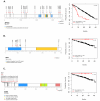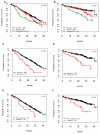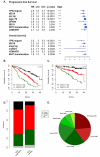Mutational Spectrum, Copy Number Changes, and Outcome: Results of a Sequencing Study of Patients With Newly Diagnosed Myeloma
- PMID: 26282654
- PMCID: PMC6485456
- DOI: 10.1200/JCO.2014.59.1503
Mutational Spectrum, Copy Number Changes, and Outcome: Results of a Sequencing Study of Patients With Newly Diagnosed Myeloma
Abstract
Purpose: At the molecular level, myeloma is characterized by copy number abnormalities and recurrent translocations into the immunoglobulin heavy chain locus. Novel methods, such as massively parallel sequencing, have begun to describe the pattern of tumor-acquired mutations, but their clinical relevance has yet to be established.
Methods: We performed whole-exome sequencing for 463 patients who presented with myeloma and were enrolled onto the National Cancer Research Institute Myeloma XI trial, for whom complete molecular cytogenetic and clinical outcome data were available.
Results: We identified 15 significantly mutated genes: IRF4, KRAS, NRAS, MAX, HIST1H1E, RB1, EGR1, TP53, TRAF3, FAM46C, DIS3, BRAF, LTB, CYLD, and FGFR3. The mutational spectrum is dominated by mutations in the RAS (43%) and nuclear factor-κB (17%) pathways, but although they are prognostically neutral, they could be targeted therapeutically. Mutations in CCND1 and DNA repair pathway alterations (TP53, ATM, ATR, and ZNFHX4 mutations) are associated with a negative impact on survival. In contrast, those in IRF4 and EGR1 are associated with a favorable overall survival. We combined these novel mutation risk factors with the recurrent molecular adverse features and international staging system to generate an international staging system mutation score that can identify a high-risk population of patients who experience relapse and die prematurely.
Conclusion: We have refined our understanding of genetic events in myeloma and identified clinically relevant mutations that may be used to better stratify patients at presentation.
Trial registration: ClinicalTrials.gov NCT01554852.
© 2015 by American Society of Clinical Oncology.
Figures




Similar articles
-
Effect of MAPK activation via mutations in NRAS, KRAS and BRAF on clinical outcome in newly diagnosed multiple myeloma.Hematol Oncol. 2023 Dec;41(5):912-921. doi: 10.1002/hon.3208. Epub 2023 Jul 15. Hematol Oncol. 2023. PMID: 37452600
-
Mutations In Thirty Hotspot Genes In Newly Diagnosed Chinese Multiple Myeloma Patients.Onco Targets Ther. 2019 Nov 21;12:9999-10010. doi: 10.2147/OTT.S216289. eCollection 2019. Onco Targets Ther. 2019. PMID: 31819496 Free PMC article.
-
BRAF and DIS3 Mutations Associate with Adverse Outcome in a Long-term Follow-up of Patients with Multiple Myeloma.Clin Cancer Res. 2020 May 15;26(10):2422-2432. doi: 10.1158/1078-0432.CCR-19-1507. Epub 2020 Jan 27. Clin Cancer Res. 2020. PMID: 31988198
-
Multiple Myeloma Genomics: A Systematic Review.Semin Oncol Nurs. 2017 Aug;33(3):237-253. doi: 10.1016/j.soncn.2017.05.001. Epub 2017 Jul 18. Semin Oncol Nurs. 2017. PMID: 28729121 Review.
-
Progress in the identification of gene mutations involved in multiple myeloma.Onco Targets Ther. 2019 May 24;12:4075-4080. doi: 10.2147/OTT.S205922. eCollection 2019. Onco Targets Ther. 2019. PMID: 31213829 Free PMC article. Review.
Cited by
-
Evaluation of in vitro effects of various targeted drugs on plasma cells and putative neoplastic stem cells in patients with multiple myeloma.Oncotarget. 2016 Oct 4;7(40):65627-65642. doi: 10.18632/oncotarget.11593. Oncotarget. 2016. PMID: 27582537 Free PMC article.
-
Survival prediction and treatment optimization of multiple myeloma patients using machine-learning models based on clinical and gene expression data.Leukemia. 2021 Oct;35(10):2924-2935. doi: 10.1038/s41375-021-01286-2. Epub 2021 May 18. Leukemia. 2021. PMID: 34007046
-
Gene mutations in newly diagnosed multiple myeloma patients detected by next-generation sequencing technology.Cancer Pathog Ther. 2024 Jan 3;2(3):205-211. doi: 10.1016/j.cpt.2023.12.004. eCollection 2024 Jul. Cancer Pathog Ther. 2024. PMID: 39027150 Free PMC article.
-
The Use of Murine Models for Studying Mechanistic Insights of Genomic Instability in Multiple Myeloma.Front Genet. 2019 Aug 15;10:740. doi: 10.3389/fgene.2019.00740. eCollection 2019. Front Genet. 2019. PMID: 31475039 Free PMC article. Review.
-
Multiple myeloma with high-risk cytogenetics and its treatment approach.Int J Hematol. 2022 Jun;115(6):762-777. doi: 10.1007/s12185-022-03353-5. Epub 2022 May 9. Int J Hematol. 2022. PMID: 35534749 Free PMC article. Review.
References
-
- Morgan GJ, Walker BA, Davies FE. The genetic architecture of multiple myeloma. Nat Rev Cancer. 2012;12:335–48. - PubMed
-
- Klein U, Jauch A, Hielscher T, et al. Chromosomal aberrations +1q21 and del(17p13) predict survival in patients with recurrent multiple myeloma treated with lenalidomide and dexamethasone. Cancer. 2011;117:2136–44. - PubMed
-
- Greipp PR, San Miguel J, Durie BG, et al. International staging system for multiple myeloma. J Clin Oncol. 2005;23:3412–20. - PubMed
Publication types
MeSH terms
Substances
Associated data
Grants and funding
LinkOut - more resources
Full Text Sources
Other Literature Sources
Medical
Research Materials
Miscellaneous

